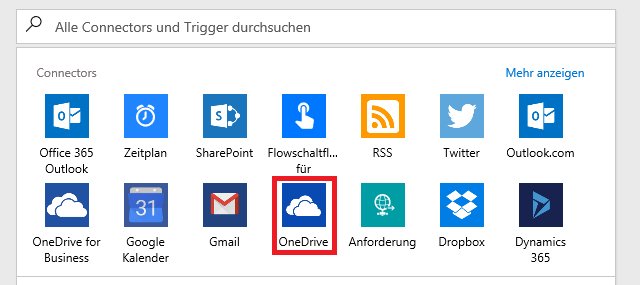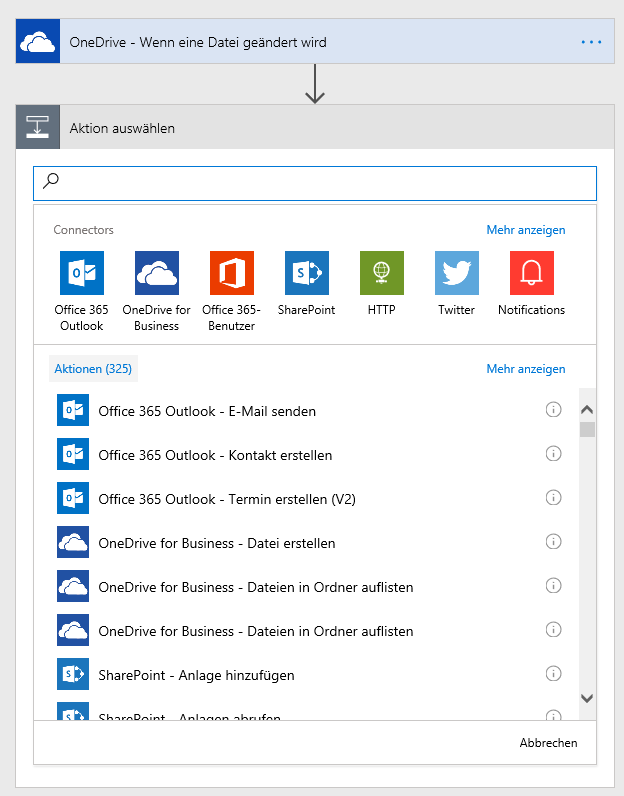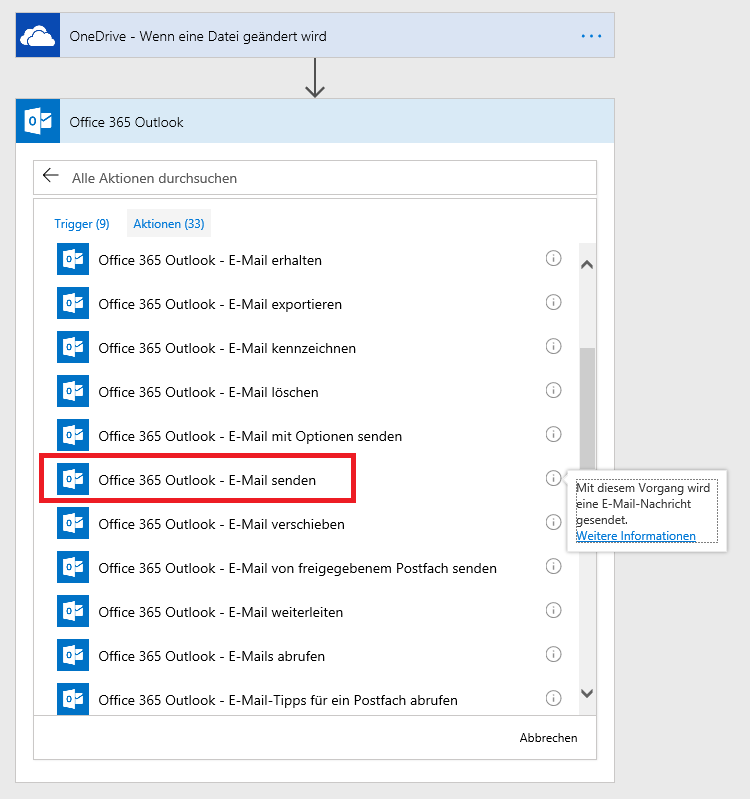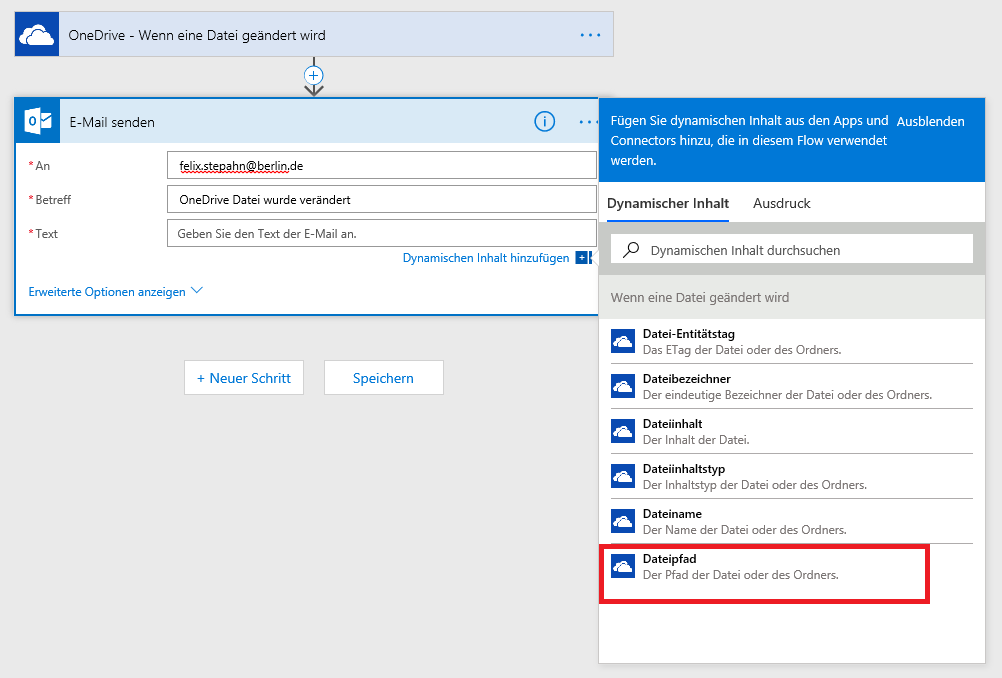Die Idee hinter Microsoft Flow ist es Workflows in der Microsoft Cloud abzubilden, sie zu automatisieren und stellt eine Schnittstelle über die O365 Produktpalette und darüber hinaus dar. Ich möchte in diesem Artikel auf die Grundlegenden Werkzeuge eingehen die existieren um einen Flow zu definieren.
Connector: Die Schnittstelle zwischen eurem Flow und einer O365 App
Trigger: Eine Ereignis innerhalb einer App welche eine Reaktion eures Flows “triggert”
Aktionen: Die Reaktion, welche auf einen ausgelösten Trigger erfolgen soll
Bedingung: Eine Bedingung ist eine Prüfung auf X die entweder Wahr oder Falsch sein kann. X kann hier der Vergleich eines Numerischer Wertes sein, die Prüfung auf einen bestimmten Dateityp, oder ein logischer ausruck wie and(Y, Z).
Parameter: Noch nicht sicher, wirkt ähnlich wie Bedingung (Englischer Name “option”)
“Apply to Each”-Schleife: Ist eine “for each” Schleife. Hiermit kann eine Definierte Aktion auf jedes Element einer Liste angewendet werden.
“Do … Until”-Schleife: Macht was der Name sagt, sie wiederholt eine definierte Aktion und prüft am Ende dieser Aktion ob die Bedingung erfüllt ist, welche die Schleife beendet.
Bereich: Hier bin ich mir noch nicht sicher, was das macht
Flow Beispiele
Als Connector wähle ich OneDrive.

Als Trigger wähle ich “Wenn eine Datei geändert wird”.

Jetzt füge ich dem Flow eine weitere Aktion hinzu.

Ich entscheide mich dafür, dass eine Aktion mit dem O365 Outlook Connector ausgeführt werden soll.

Die Aktion die ich Wähle ist Office 365 Outlook - E-Mail senden.

Als Werte dieser Aktion muss ich nun noch auswählen, an wen die Mail gesendet wird, mit welchem Betreff und welchem Inhalt. Ich wähle mich selbst als Empfänger, den Betreff wähle ich mich “Eine OneDrive Datei wurde geändert” und den Inhalt der Mail lasse ich mit dem Dynamischen Inhalt “Dateipfad” befüllen.

So erhalte ich jetzt jedes mal wenn eine bestimmte Datei in OneDrive geändert wird eine Mail mit der Info das eine Datei geändert wurde und dem Dateipfad. Wir haben also mit relativ wenig Aufwand mehrere O365 Apps miteinander verbunden und eine Benachrichtigung automatisiert.
Komplexere Workflows
Seine Stärke spielt Microsoft Flow aus, wenn man komplexere Workflows definiert. So ist es beispielsweise möglich eine Anmeldeformular für eine Weiterbildung zu schreiben welches im SharePoint einer Firma veröffentlicht wird. Wenn jemand dieses Formular ausfüllt wird eine Kopie davon an den Vorgesetzten, definiert in AzureAD, per Mail geschickt mit einer bitte um Bestätigung oder Ablehnung. Wenn der vorgesetzte dem nicht entspricht erhält der User eine Absage.
Wenn der Manager dem zustimmt wird eine Mail mit Bitte um Bestätigung der Reisekostenübernahme an Finance geschickt. Wenn Finance zustimmt und eine Prüfung ob die Anzahl ungebuchter Fahrzeuge im Fahrzeugpool größer X ist erfolgreich war, wird das Formular weiter an HR geschickt, damit diese das Hotel buchen und den Mitarbeiter anmelden kann.
Anschließend erhalten alle involvierten Parteien eine Bestätigungsmail, dass der Prozess abgeschlossen ist und dem Mitarbeiter wird ein Outlooktermin und eine Abwesenheitsnotiz eingerichtet.
Ihr seht es lassen sich sehr viele Usecases für Flows ausdenken.
Cheers, Ori